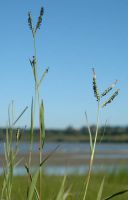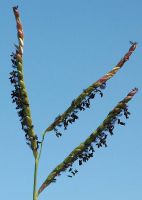Distribution: Occurring chiefly along the lower Columbia River corridor in Washington; British Columbia to California, east across most of North America to the Atlantic Coast.
Habitat: Along ditches and streams where the soil is moist much of the season.
Flowers: August-October
Origin: Native
Growth Duration: Perennial
Conservation Status: Not of concern
Pollination: Wind
Strongly stoloniferous perennial, the culms upright, 4-10 dm. tall, the nodes strongly pubescent.
Sheaths open, long-hairy; articulation below the glumes; ligules 1-1.5 mm. long; blades 3-8 mm. broad, the margins slightly thickened.
Inflorescence a pair of terminal spikes 2-7 cm. long; spikelets 2-flowered, 3-3.5 mm. long, flattened, attached in two rows on one side of a broadened rachis; first glume lacking, or lanceolate and 1.5 mm. long; second glume 3-nerved, about equal to the lower, 1-nerved lemma, which is sterile and glabrous; fertile upper lemma and palea hardened, slightly shorter than the sterile lemma; stamens 3; anthers and stigmas purple.
Publication: Syst. Nat. (ed. 10) 855. 1759.
Paspalum distichum L. var. indutum Shinners
Paspalum paspaloides (Michx.) Scribn.
PNW Herbaria: Specimen records of Paspalum distichum in the Consortium of Pacific Northwest Herbaria database
WA Flora Checklist: Paspalum distichum checklist entry
OregonFlora: Paspalum distichum information
E-Flora BC: Paspalum distichum atlas page
CalPhotos: Paspalum distichum photos































